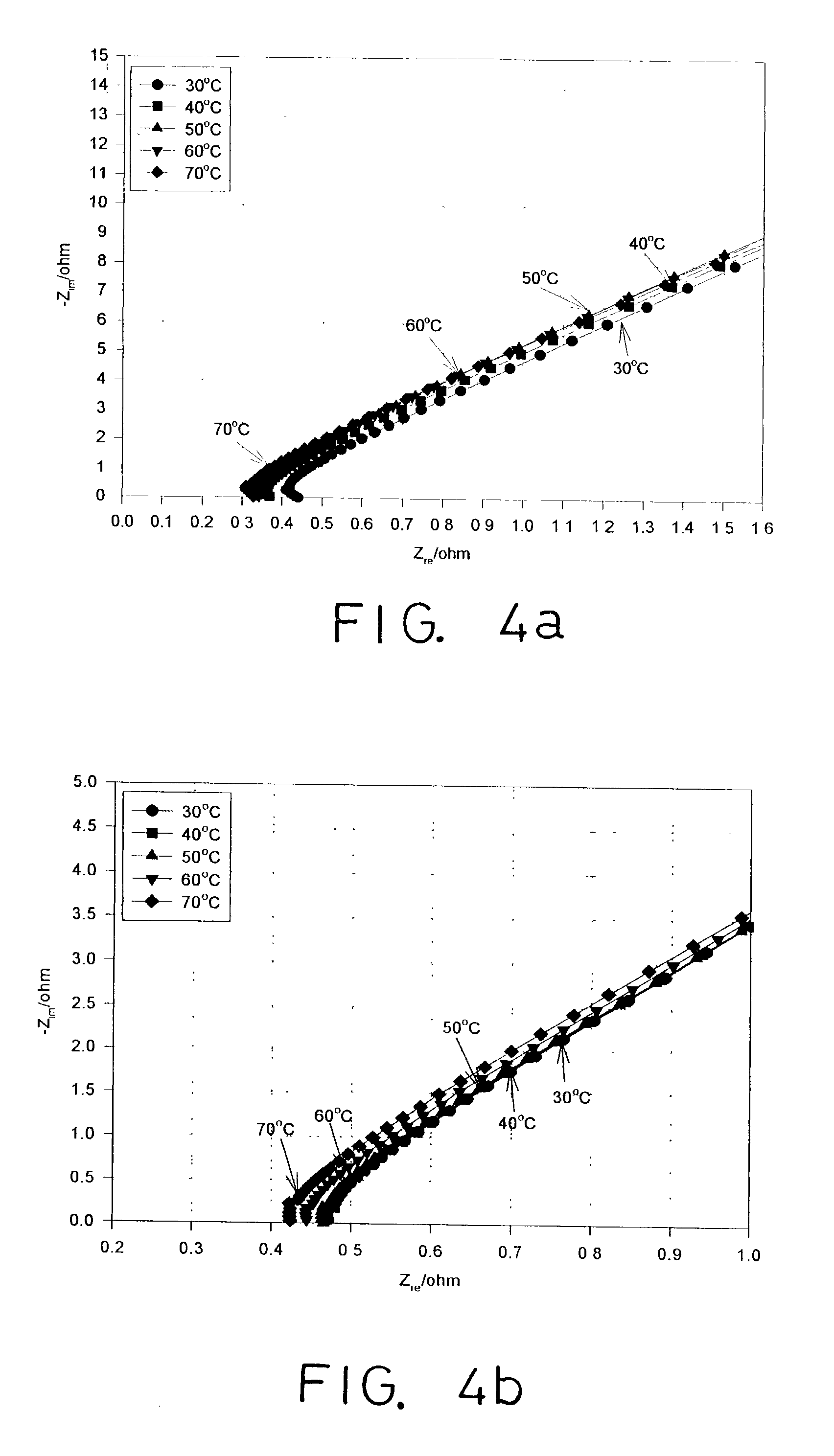Method for making solid polymer electrolyte and uses thereof
a polymer electrolyte and polymer technology, applied in the direction of non-metal conductors, cell components, sustainable manufacturing/processing, etc., can solve the problems of hard and brittle glass materials, unmatched ordinary glass wide application range, and poor mechanical strength of ordinary separators
- Summary
- Abstract
- Description
- Claims
- Application Information
AI Technical Summary
Problems solved by technology
Method used
Image
Examples
embodiment 1
[0058] Weigh accurately 8.0 g of polyvinyl alcohol (PVA) and 40 g of water and place them into reactor. Measure the weight of reactor with PVA, water and agitator in it and record it. Agitate for one hour under ambient temperature until PVA is completely dissolved. Dissolve 12.5 g of potassium hydroxide (KOH) in 100 g of water and then pour it into the reactor. Raise the reactor temperature to 60-70.degree. C. and control the polymerization time to under 30 minutes. Measure the weight of reactor with resulting polymer inside and record it, and spread viscous polymer of specific weight (about 5-10 g polymer solution) on glass fiber (GF) and place it in temperature / humidity chamber (control the humidity at 30-40 RH % and temperature at 50-60.degree. C.) for one hour. After that, take it out and leave it in atmosphere for 30 minutes to one hour. Remove the polymer film and weigh it to calculate its chemical composition after drying. Preserve the polymer film in zipper tape for electroc...
embodiment 2
[0059] Take the PVA-GF polymer film obtained in Embodiment 1. Measure its thickness with digital thickness gauge and its ionic conductivity with Autolab FRA of Eco Chemie BV (dipolar stainless steel electrodes) (refer to FIGS. 4(a) and 4(b)). The composition of PVA:KOH:H.sub.2O in the PVA-GF polymer film is found to be 30:30:40 wt %; molecular weight (MW) of PVA is 75,000-80,000; its thickness is 0.58 mm or 0.6 mm.
[0060] The cyclic voltammetry obtained with Autolab FRA (made in Netherlands) is as shown in FIGS. 6(a) and 6(b), from which it is learned that in comparison with PVA film under ambient temperature, the PVA-GF polymer electrolyte in this preferred embodiment did not undergo any oxidation and reduction reaction within working voltage stability of -1.4-1.4V, i.e. there was absence of Faradic current flow. PVA-GF electrolyte exhibited better electrochemical stability than commercially available PP / PE separator (voltage stability of -1.0V-1.0V) and cellulose separator (voltage...
embodiment 3
[0062] Take 2.5 g zinc gel consisting of 70 wt % zinc powder, PTFE and KOH as cathode and self-prepared air electrode as anode to assemble zinc-air batteries using PP / PE and cellulose as separator respectively. In addition, take the PVA-GF film electrolyte from Embodiment 1 herein to replace the aforesaid PP / PE and cellulose separator in the assembly of another zinc-air battery, and compare the discharge property of different batteries (see Table 4). Keep the theoretical capacitance of the batteries at 1,500 mAh and use discharge current of 50 mA, 100 mA, 150 mA and 200 mA under ambient temperature. The results are as shown in FIGS. 8(a), (b) and (c). In FIG. 8(a) at the discharge rate of C / 10, the discharge time of zinc-air battery using PP / PE as separator was 8.9 hours and its utilization rate was 89.33%; the discharge time of zinc-air battery using cellulose as separator was 8.1 hours and its utilization rate was 81%; and the discharge time of zinc-air battery using PVA-GF film c...
PUM
| Property | Measurement | Unit |
|---|---|---|
| temperature | aaaaa | aaaaa |
| RH | aaaaa | aaaaa |
| temperature | aaaaa | aaaaa |
Abstract
Description
Claims
Application Information
 Login to View More
Login to View More - R&D
- Intellectual Property
- Life Sciences
- Materials
- Tech Scout
- Unparalleled Data Quality
- Higher Quality Content
- 60% Fewer Hallucinations
Browse by: Latest US Patents, China's latest patents, Technical Efficacy Thesaurus, Application Domain, Technology Topic, Popular Technical Reports.
© 2025 PatSnap. All rights reserved.Legal|Privacy policy|Modern Slavery Act Transparency Statement|Sitemap|About US| Contact US: help@patsnap.com



